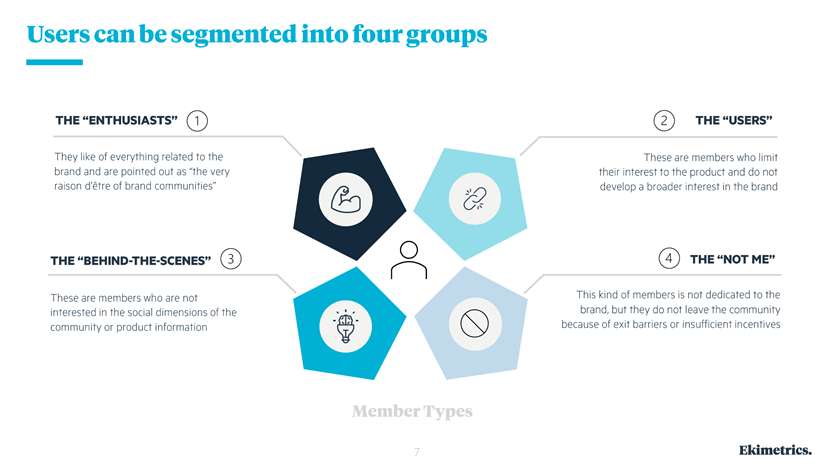
By Matt Andrews, Managing Director, Ekimetrics
“Man is a social animal,” wrote Aristotle. Quite what the Greek philosopher would have made of our social media-fuelled digital age we can’t be sure, but this maxim is surely as true now as it was 2,000 years ago.
If anything, we’ve never been so connected. The rise of cloud data and social technologies has led to new interactive platforms that have brought different cultures, countries and creeds together into far-reaching, digital eco-systems.

Matt Andrews, Managing Director, Ekimetrics
And where people go, marketers must follow. The borders between consumers are coming down. As a result, many brands are reaching out to new groups and partners with shared interests and values as the traditional boundaries between industries disappear.
We are entering the era of brand communities – where collaboration is critical, and the consumer comes before the product.
What makes a brand community?
One of the most important attributes of brand community is a “consciousness of kind.” Do customers feel connected to the brand? And do they feel connected to each other?
This requires brands to converse with their audience, not broadcast to them. A brand community should cultivate a sense of belonging to a distinctive social category with its own culture, values, and behaviours. And it should support a collective sense of moral responsibility, where community members feel a mutual sense of commitment to one another.
While this may sound a little lofty, at its heart a brand community is like any other: a group of passionate people coming together to share their interests.
It’s where these interests and values intersect and where brands must look if they don’t want to risk being left behind.
The benefits of a data-first approach
To develop and keep up with their communities, brands need to make the most of all available data.
Firstly, brands need to be able to spot early signs of change and gain a deep understanding of how market drivers affect their business – including what motivates their customers’ behaviour. By forecasting scenarios, businesses can identify both opportunities and threats, developing a more agile approach to build their brand and hone their campaigns. By doing so, they can predict trends rather than just follow them.
Secondly, brands need to drill down into the makeup and structure of their communities. By understanding the level of engagement within a community, brands can gauge the differences between enthusiasts, members who are only interested in certain products, and those who are not engaged but still present.
In addition, knowing how the community is connected is critical to developing communications strategies. Are a brand’s audiences in accessible pools, connected through their web of relationships, or united through a central hub? How can each of those support the others?
Finally, customer behaviour data is a rich source of opportunity. Brands can capitalise on cross-brand fusion by following connections wherever they may lead, including outside of typical business areas.
Communities can also be an integral part of product and brand development. Co-created opportunities can turn consumers as into brand advocates. And by providing spaces for communities to live – such as through an app – brands can encourage consumers to make purchases, create a platform for targeted engagement, and gain significant insight that can be fed into product, creative and targeting decisions.
Finding an authentic voice
However, a brand’s values must still be authentic. Consumers are becoming increasingly savvy, particularly around issues like sustainability that have been suspectable to greenwashing practices in the past. Here, partnerships can lend credibility to campaigns while helping to amplify worthy messages.
For example, Levi’s “Buy Better, Wear Longer” campaign earlier this year, aimed at tackling fast fashion by encouraging people to wear items longer and even buy second-hand – a bold move for a fashion retailer. They partnered with young activists – including Marcus Rashford and Jaden Smith – to help make sure their message reached a Gen Z audience across its social channels.
Importantly, the campaign sought to promote a sense of shared responsibility, encouraging everyone to play their part – that sense of joint moral commitment we talked about earlier.
Encouraging participation through rewards
Of course, creating a community is one thing. Keeping them engaged is quite another.
A brand can encourage community interactions by offering value through campaigns, promotions, and rewards.
Meanwhile, customer to customer interactions can be a powerful way of creating community credibility while driving conversion. What could be more powerful than seeing like-minded people wearing a fashion brand’s clothing, or car owners showing off their new ride to their peers?
Some brands have shown how effective this approach can be. For example, the Nike+ community cultivates peer to peer support via its website, app and subscription service. This helps drive brand advocacy whilst being aligned to a shared set of health and fitness values.
A bright, collaborative future
Brand communities take time and effort. They are not created by chance. And they won’t be suitable for every business or industry. But in the right circumstances they can create significant value.
For these communities to be successful, brands must be able a deep dive into the data to understand how to reach their audience – and then partner with the right people at the right time to amplify and reinforce their message.
Many brands have shown they can create communities that are socially conscious, values-driven, and effective at driving sales. Surely that’s something that all marketers can get on board with.


